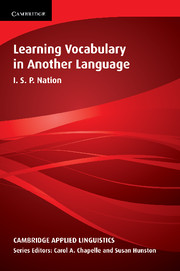Book contents
- Frontmatter
- Contents
- Series editors' preface
- Acknowledgements
- Introduction
- 1 The goals of vocabulary learning
- 2 Knowing a word
- 3 Teaching and explaining vocabulary
- 4 Vocabulary and listening and speaking
- 5 Vocabulary and reading and writing
- 6 Specialised uses of vocabulary
- 7 Vocabulary learning strategies and guessing from context
- 8 Word study strategies
- 9 Chunking and collocation
- 10 Testing vocabulary knowledge and use
- 11 Designing the vocabulary component of a language course Goals
- Appendixes
- References
- Subject index
- Author index
11 - Designing the vocabulary component of a language course Goals
Published online by Cambridge University Press: 05 October 2012
- Frontmatter
- Contents
- Series editors' preface
- Acknowledgements
- Introduction
- 1 The goals of vocabulary learning
- 2 Knowing a word
- 3 Teaching and explaining vocabulary
- 4 Vocabulary and listening and speaking
- 5 Vocabulary and reading and writing
- 6 Specialised uses of vocabulary
- 7 Vocabulary learning strategies and guessing from context
- 8 Word study strategies
- 9 Chunking and collocation
- 10 Testing vocabulary knowledge and use
- 11 Designing the vocabulary component of a language course Goals
- Appendixes
- References
- Subject index
- Author index
Summary
This chapter draws together many of the ideas discussed in other chapters by looking at the points to consider when doing curriculum design on the vocabulary component of a language course. It also describes important vocabulary principles by seeing how learners can be encouraged to take control of their vocabulary learning. This chapter follows a traditional model of curriculum design shown in Figure 11.1 (Nation, 2000b).
Goals
In general, the goals of the vocabulary component of a course will be to increase learners' usable vocabulary size and to help learners gain effective control of a range of vocabulary learning and coping strategies. ‘Usable’ vocabulary size implies that learners need to not only increase the vocabulary they know but also develop the fluency and skill with which they can use that vocabulary in the relevant language skills of listening, speaking, reading and writing. Similarly, ‘effective control’ of strategies implies that learners need to not only learn appropriate strategies but be confident and fluent in their use.
In order to set specific goals, it is essential to know if learners need to focus on high-frequency, academic, technical or low-frequency words. This is best decided on by diagnostic testing using the Vocabulary Levels Test or another, similar test. Knowing which of these four types of vocabulary to focus on is essential knowledge for course design because high-frequency vocabulary and low-frequency vocabulary need to be dealt with by the teacher in quite different ways.
- Type
- Chapter
- Information
- Learning Vocabulary in Another Language , pp. 380 - 406Publisher: Cambridge University PressPrint publication year: 2001

